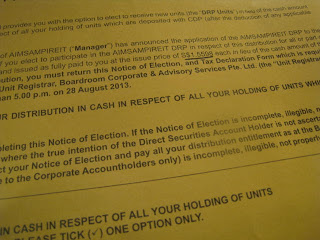I know someone who finds it very hard to save money.
He has hardly any savings as he spends money very freely. He sees, he likes, he buys.
He is also generous to a fault.
So, you can imagine that he is rather popular amongst his friends.
When I asked him if he was worried about having very little savings, he replied that there is always next month's pay cheque.
This feeling of invincibility in an environment of extremely low unemployment in Singapore could be increasingly common but that is another topic.
Anyway, as I talked to him, I found that he is really a very pleasant person. No airs and not given to showing off.
He is simply very easy with money.
He vaguely knows the importance of saving but being very comfortable now, he just spends freely. It has become a habit.
So, since we arrived at the conclusion that if he sees money, he would be inclined to spend it, the only way for him to save is not to see the money.
 |
| Top up CPF-SA. |
I suggested that he does the following:
1.
Start an SRS account and contribute the maximum of S$ 12,750 a year. (From 2016: $15,300).
2. Minimum Sum Top Up of $7,000 a year to his CPF-Special Account.
3. Religiously lock up 10% of his monthly take home pay in 12 months fixed deposits with the auto renewal option intact.
#1 and #2 will also help in reducing the amount of income tax payable while #3 will help to create a higher level of liquidity. He needs to build up an emergency fund pronto.
Having never given much thought to how he should build up his savings, he said that the suggestions are practicable and also practical.
He decided to adopt all three measures.
I am glad I was able to help him take an important step towards personal financial security.
If we know people who make a good salary but have trouble with saving money due to spending habits, talk to them.
We would be doing a good deed.
Related posts:
1. The very first step to becoming richer.
2. A common piece of advice on savings.
3. Build a bigger retirement fund: CPF-SA.
4. SRS: A brief analysis.
5. Ambassadors of financial freedom.






































